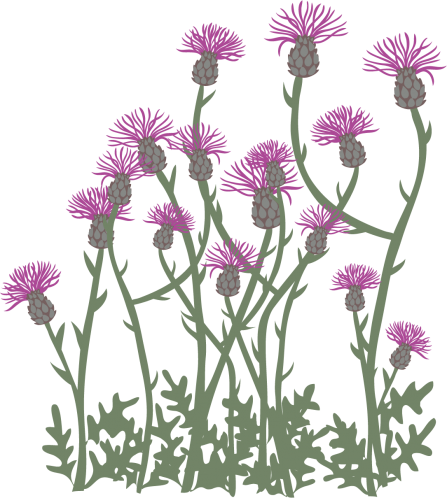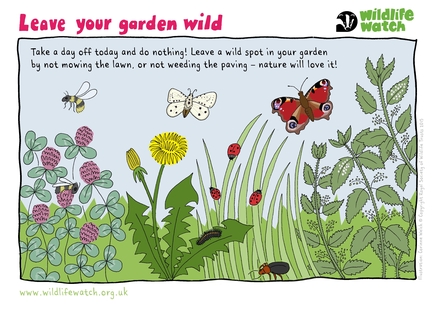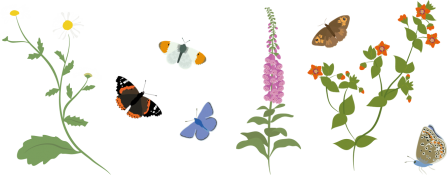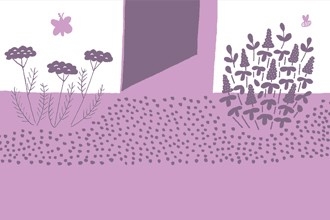
How to grow a wild patch or mini meadow

Option 1 - Let your grass grow long
Long grass, peppered with flowers, is one of the rarest habitats in our well-tended gardens, yet it is incredibly beneficial for wildlife. Patches of long grass encourage different plant species to grow, help insects to thrive and create feeding opportunities for birds and small mammals.
So simply let nature move in! Set aside some lawn, leaving it to grow, and wait to see what arrives. The less pristine the lawn, the more promising it is for wildlife. You can raise the cutters on your mower to make some paths and leave the rest of the mowing until July or August after plants have flowered.

Let nature move in or sow your own wildflower patch; bring a touch of wild to your garden
Option 2 - Start from scratch
You can create a wildflower area from scratch on bare ground. Pick a poor patch of ground that hasn’t been cultivated recently. Wildflower meadows establish best on unproductive soil. It’s worth checking what sort of soil you have and its pH before you choose which seeds to sow; wildflower seed merchants supply mixes suitable for various soil types and situations.
If your soil fertility is too high for perennial wildflowers to flourish, consider sowing a cornfield annual mix that includes plants like cornflower, corn poppy, corn marigold and corncockle, with some barley and wheat seed to add an authentic touch!
To create your patch from scratch:
- Control weeds by digging or rotovating, burying any vegetation to a depth of 15-20 cm. This also brings less fertile soil to the surface.
- Firm and rake the surface to make a seedbed.
- Don’t be tempted to add manure or fertiliser as this will encourage excessive vigour in the grasses, which then swamp the wildflowers. This is the most important principle in establishing a wildflower meadow.
- Sow in autumn, giving the seed time to settle in over winter. If you are on heavy clay, however, it is better to wait until spring. Even large areas can be sown by hand quite easily.
- Ensure that the seed is scattered evenly by sowing half lengthways and the remaining half widthways across the plot. Mixing the seed with silver sand makes the process easier. Rake in lightly and water thoroughly.

Suggested plants
If you're planting in the spring
- Dropwort
- Grape hyacinth
- Red campion
- Oxlip
- Foxglove
- Primrose
- Cowslip
- Ribwort plantain
- Black medick
- Hoary plantain
- Selfheal
- Wild daffodil
- Bluebell
- Sweet cicily
- Meadow buttercup
- Ox-eye daisy
- Cow parsley
- Cock's-foot
- Sheep's-fescue
- Yorkshire-fog
- Wild thyme
- Lady's bedstraw
- Chamomile
If you're planting in the summer
- Autumn hawbit
- Feverfew
- Meadowset
- Teasel
- Betany
- Field Scabious
- Musk mallow
- Toadflax
- Foxglove
- Bird’s-foot-trefoil
- Tufted vetch
- Bladder campion
- Goatsbeard
- Pignut
- Scentless mayweed
- Oxeye-daisy
- White campion
- Wild carrot
- Common agrimony
- Greater knapweed
- Purple loosestrife
- Red clover
- Red campion
- Perforate St John's Wort
- Ribwort plantain
- Yarrow
- Harebell
- Wild thyme
- Yellow rattle
- Common mallow
- Hoary plantain
- Devil's-bit scabious
- Viper's bugloss
- Kidney vetch
- Salad burnet
- Lady's bedstraw
- Nettle leaved bell flower
- Dropwort
- Dryers greenweed
- Selfheal
- Lesser knapweed
- Meadow cranesbill
- Small scabious
- Cock's-foot
- Sheep's-fescue
- Bulbous buttercup
Maintaining your wild patch
During the first year, it is essential to get the mowing regime right. Cut to 5-7 cm whenever the height reaches 10-20 cm. The number of mows required can range from one to four. Control assertive weeds like thistles, nettles and docks by hand-weeding.
After this, a couple of cuts a year should be enough. Once in late July/early August and then again in early autumn. After mowing, always leave the clippings for a couple of days to drop any seed, then rake up and remove to keep soil fertility down.
Top tips
- Be careful when mowing – small mammals, amphibians and reptiles may be hiding in the grass. Some birds nest in larger meadows, so don’t mow until after the beginning of August.
- Wildflowers are available in plug form and in ready-planted turf rolls, which can make establishing the plants even easier.
- Sow a mix of wild grass and wild flower seed.



